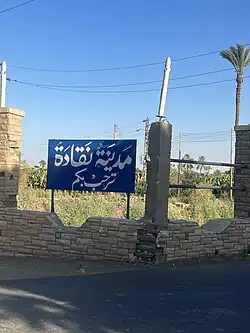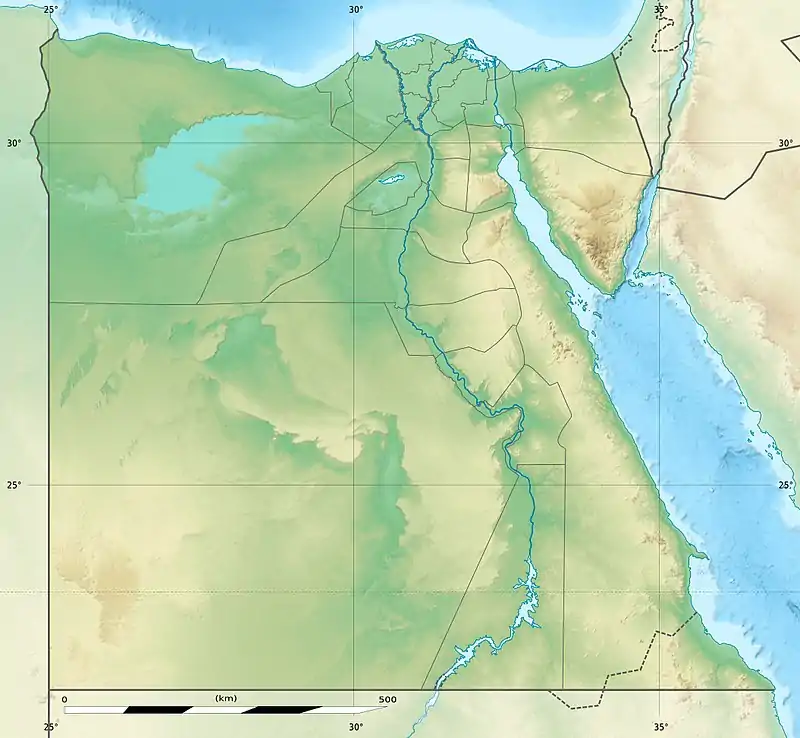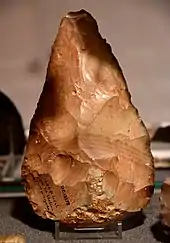Naqada
Naqada (Egyptian Arabic: نقادة Naqāda; Coptic language: ⲛⲉⲕⲁⲧⲏⲣⲓⲟⲛ Nekatērion;[4] Ancient Greek: Παμπανις Pampanis[3], Ancient Egyptian: Nbyt), is a town on the west bank of the Nile in Qena Governorate, Egypt, situated ca. 20 km north of Luxor. It includes the villages of Tukh, Khatara, Danfiq, and Zawayda. According to 1960 census, it is one of the most uninhabited areas and had only 3,000 inhabitants, mostly of Christian faith[5] who preserved elements of the Coptic language up until the 1930s.[6]
Naqada
نقادة نبت Nbyt | |
|---|---|
 | |
 Naqada نقادة Location in Egypt | |
| Coordinates: 25°54′N 32°43′E | |
| Country | |
| Governorate | Qena Governorate |
| Area | |
| • Total | 35.94 sq mi (93.08 km2) |
| Population (2021)[1] | |
| • Total | 188,984 |
| • Density | 5,300/sq mi (2,000/km2) |
| Time zone | UTC+2 (EST) |
| • Summer (DST) | +3 |
| nbyt[2][3] in hieroglyphs | |||||
|---|---|---|---|---|---|
| Era: Middle Kingdom (2055–1650 BC) | |||||
Archaeology
Naqada stands near the site of a prehistoric Egyptian necropolis: The town, called Ombos, was the centre of the cult of Set and large tombs were built there c. 3500 BCE.[7]
The large quantity of remains from Naqada has enabled the dating of the entire archeological period throughout Egypt and its environs, hence the town name Naqada is used for the pre-dynastic Naqada culture c. 4400–3000 BCE. Other Naqada culture archeological sites include el Badari, the Gerzeh culture, and Nekhen.
In popular culture
In the Stargate franchise, alien civilizations make extensive use of a mineral, naquada, named after the archaeological site.
Gallery
 Sickle made of flint, Egypt, Naqada period, end of the fourth millennium BCE, Dagon Museum, Haifa
Sickle made of flint, Egypt, Naqada period, end of the fourth millennium BCE, Dagon Museum, Haifa Acheulean hand-axe from Egypt. Found on a hilltop plateau, 1400 feet above sea level, 9 miles NNW of the city of Naqada, Egypt. Paleolithic. The Petrie Museum of Egyptian Archaeology, London
Acheulean hand-axe from Egypt. Found on a hilltop plateau, 1400 feet above sea level, 9 miles NNW of the city of Naqada, Egypt. Paleolithic. The Petrie Museum of Egyptian Archaeology, London_II_on_right_arm._From_the_temple_of_Seth_at_Naqqada%252C_Egypt._The_Petrie_Museum_of_Egyptian_Archaeology%252C_London.jpg.webp) Black granite, seated statue of Sennefer with cartouche of Amenhotep II (Amenophis) on right arm. From the temple of Seth at Naqada, Egypt. The Petrie Museum of Egyptian Archaeology, London
Black granite, seated statue of Sennefer with cartouche of Amenhotep II (Amenophis) on right arm. From the temple of Seth at Naqada, Egypt. The Petrie Museum of Egyptian Archaeology, London
 Evolution of Egyptian prehistoric pottery styles, from Naqada I to Naqada II and Naqada III
Evolution of Egyptian prehistoric pottery styles, from Naqada I to Naqada II and Naqada III_at_Naqada%252C_Egypt._18th_Dynasty._The_Petrie_Museum.jpg.webp) Limestone architectural fragment. A door jamb, part of a doorway. From the temple of Seth (which was built by Thutmosis III) at Naqada, Egypt. 18th Dynasty. Petrie Museum
Limestone architectural fragment. A door jamb, part of a doorway. From the temple of Seth (which was built by Thutmosis III) at Naqada, Egypt. 18th Dynasty. Petrie Museum
See also
References
- "Naqādah (Markaz, Egypt) - Population Statistics, Charts, Map and Location". citypopulation.de. Retrieved 17 March 2023.
- Wallis Budge, E. A. (1920). An Egyptian hieroglyphic dictionary: with an index of English words, king list and geological list with indexes, list of hieroglyphic characters, coptic and semitic alphabets, etc. Vol. 2. John Murray. p. 1005.
- Gauthier, Henri (1926). Dictionnaire des Noms Géographiques Contenus dans les Textes Hiéroglyphiques. Vol. 3. p. 84.
- Ishak, Emile Maher (1975). The Phonetics and Phonology of the Boḥairic Dialect of Coptic and the Survival of Coptic Words in the Colloquial and Classical Arabic of Egypt and of Coptic Grammatical Constructions in Colloquial Egyptian Arabic. Vol. 1. University of Oxford. p. 164.
- "Discrepancies between Coptic statistics" (PDF).
- Worrell, W. H. (1937). "Popular traditions of the Coptic language". American Journal of Semitic Languages and Literatures. 54 (1/4): 1–11. doi:10.1086/370517. JSTOR 529250. S2CID 170527828.
- Rice, Michael (2003). Egypt's Making: The origins of ancient Egypt 5000–2000 BC. Taylor & Francis. p. 75. ISBN 978-0-203-42816-0 – via Google Books.